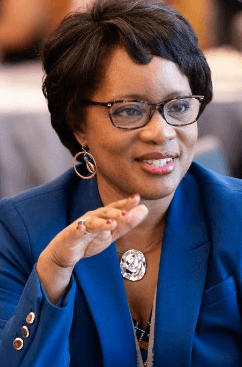Physically Apart, but Still Together

Stephanie Wiggins is the Chief Executive Officer of Metrolink, a regional commuter railroad serving six Southern California counties with nearly 10,000,000 annual boardings operating over 538 route miles with a budget of $793 million.
As we enter our sixth month of living through a global pandemic, my top priority as a CEO of an essential public transportation provider is keeping my team and riders safe and healthy. Early on – and even through today – we did the necessary work to keep everyone safe. We enhanced our cleaning procedures, doubled our hand sanitizing stations on our trains and we are providing everyone with face masks – employees and riders – so that we can offer safe transportation to the region’s essential workers.
Through this process, it became clear that physical safety was just the starting point. Living through a global pandemic brings about anxiety. People are worried about their health and their job and childcare. Meanwhile, physical separation and a loss of the in-person connection can lead to isolation and depression. These are serious issues that can affect the human condition, which also impacts the way we show up as employees in a virtual workplace.
The National Center for Health Statistics and Census Bureau’s Household Pulse Survey, taken between April 23, 2020, and July 21, 2020, shows that 30 percent of adults had symptoms of depressive disorder, compared to 6.6 percent last year; 36 percent had symptoms of an anxiety disorder, compared to 8.2 percent last year.
To address issues facing Metrolink, I began giving employees daily email updates. I wanted to let our team know the developments and our agency’s response. And I wanted them to hear it from me, so they knew their concerns were important to me. The response was positive, but we needed a stronger connection.
Like many agencies, Metrolink provides technology and programs to keep our team connected. We use Microsoft Teams and Facebook Workplace to see and hear our co-workers. But not everyone felt connected.
Many employees who live alone are just that, alone. For them, shelter at home was a sentence of solitary confinement. Also, parents of school-aged children had their lives capsized. For them, caring for kids, supervising distant learning, and working from home is mind-blowing.
As a result, I thought we could meet more needs by bringing all people together in a virtual gathering place. With that in mind, we launched 30-minute “CEO Coffee Breaks” on Teams every Monday, Wednesday, and Friday.


Living through a global pandemic brings about anxiety. People are worried about their health and their job and childcare.
STEPHANIE WIGGINS
During the CEO Coffee Break, I have themes like “ask me anything”, and “ideas for the new normal;” where sometimes I share all the things we’re working on and invite everyone to weigh in. I also evolved the Break to shine a spotlight on an employee and have them share their Metrolink story.
Sometimes we keep it light. We have an employee DJ who provides different genres of music leading into and out of the CEO Coffee Break on Fridays. The discussions are often free-wheeling. I like to hear laughter and see smiling faces. However, in the wake of the death of George Floyd, it got heavy. We heard the fears and experiences of our colleagues and we grieved together.
Information is a two-way street, and I’ve learned so much about the talents of the people who work at Metrolink. When I see them in their home environments, I appreciate how they have decorated, how patient they are with their children and pets, and the pride that some take in designing unique backgrounds for the video chats. And of course, for those essential workers who are not able to work remotely, their participation is elevated with the realization that without their dedication and commitment to still come to work, none of us would have the option to work remotely.
While our recovery timing has continually shifted, the intentional virtual connection from the CEO Coffee Break has demonstrated that maintaining physical distance does not prevent the opportunity to connect emotionally. We might be physically apart, but we are still together.
Yet, I know each person is dealing differently with this situation and the related isolation it creates. So I remind our team that the agency healthcare plan covers mental health, as well as an Employee Assistance Program that allows my team multiple visits to a mental healthcare provider at no cost.
Plus, I remind them that there are some great resources online. Mentalhealth.gov is just one of many websites dedicated to providing resources for the general public.
A key principle of Human-Centered Leadership, I cannot emphasize enough the importance of maintaining your connections through this trying time. Be there for each other, show grace, be mindful but please make sure that you are taking care of yourself. If we all commit to taking care of ourselves and each other, we will get through COVID-19 safe and healthy – mind, body, and spirit.

CAREER ADVICE

GOV TALK
